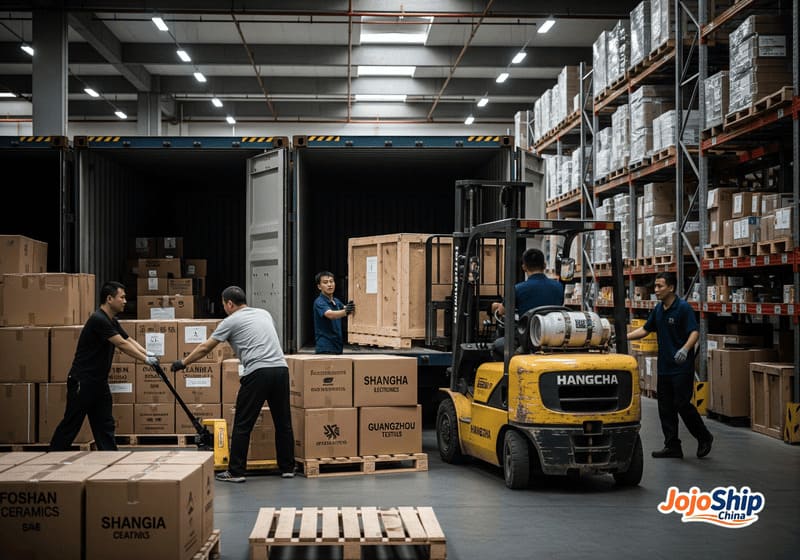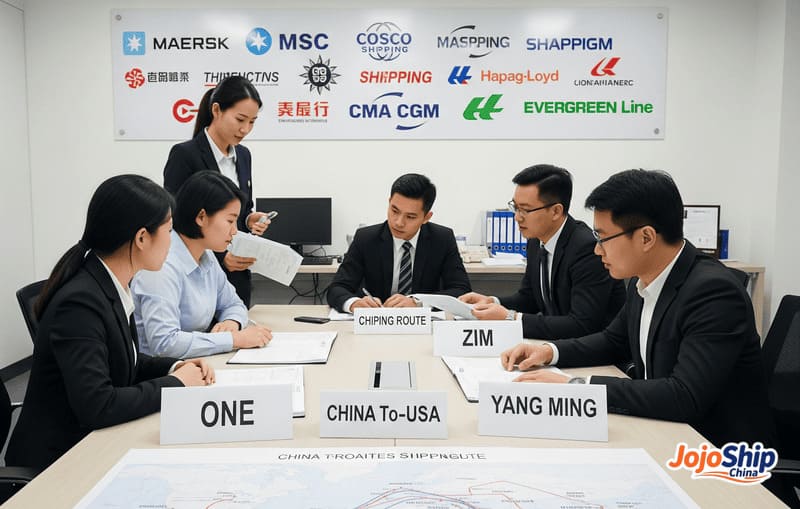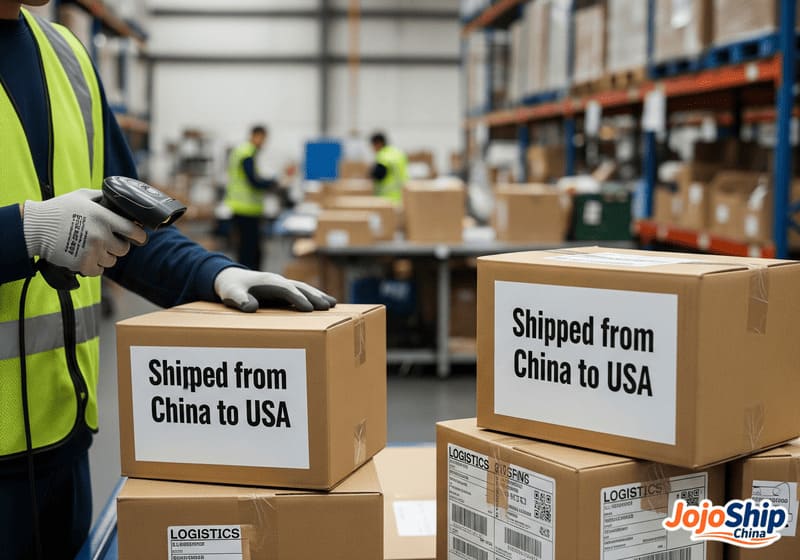You're struggling with small shipments that are too expensive to send individually, but not large enough for full containers. Finding a reliable consolidation service could cut your shipping costs by 30-50% while maintaining delivery reliability.
Consolidated shipping services from China to USA are offered by freight forwarders like MTA Lines, Dimerco, JojoShip China, Sunny Worldwide Logistics, and Cainiao. These companies combine multiple smaller shipments into single containers, providing cost savings for businesses with less-than-container load (LCL) volumes.

I've worked with hundreds of importers who were paying too much for shipping small volumes from China. One client was spending almost $8,000 monthly on separate shipments before we helped consolidate them, cutting their costs to just $3,500. Consolidated shipping isn't just about saving money—it's about making your supply chain more efficient and predictable.
What Companies Ship From China to USA?
Many businesses struggle to find reliable shipping partners for their China-USA routes, especially when they don't have enough volume for full containers, leading to unnecessarily high costs and coordination headaches.
Companies that ship from China to USA include established freight forwarders like DHL Global Forwarding, Kuehne+Nagel, and DSV, alongside specialized China-focused providers like JojoShip China, Sunny Worldwide Logistics, Baosen Suntop, and Headwin Logistics, all offering various consolidated shipping options.

Comparing Top Consolidated Shipping Providers
Not all consolidation services offer the same benefits, reliability, or pricing structures. Understanding the differences between major providers can help you select the best partner for your specific shipping needs.
| Company | Consolidation Specialties | Transittid | Min. Volume | Viktig fördel |
|---|---|---|---|---|
| MTA Lines | Direct port-to-port LCL | 25-35 dagar | 0.5 CBM | Pre-booked carrier allocations |
| Dimerco | Regular scheduled consolidations | 24-32 days | 0.3 CBM | Door-to-door service integration1 |
| JojoShip Kina | Multi-supplier consolidation | 22-30 days | 0.2 CBM | Origin warehouse network |
| Sunny Worldwide | Door-to-door consolidation | 28-35 days | 0.5 CBM | Full tracking visibility2 |
| Cainiao | E-commerce consolidation | 20-40 dagar | No minimum | Digital platform integration |
| Headwin Logistics | Global LCL network | 25-33 days | 0.3 CBM | NVOCC direct contracts |
| Baosen Suntop | Shenzhen-focused consolidation | 26-34 days | 0.5 CBM | South China expertise3 |
I've personally worked with most of these consolidators during my time in the freight industry. What I've learned is that the best provider depends heavily on your specific needs. For example, when I helped an electronics accessories client ship from multiple suppliers across China, JojoShip's multi-supplier consolidation service4 was ideal because they could collect from factories in different cities and consolidate at their warehouse.
For another client shipping exclusively from Shenzhen, Baosen Suntop provided better rates due to their strong local presence. The key factors to consider are the consolidator's presence near your suppliers, their deconsolidation capabilities near your destination, their transit time reliability, and their tracking systems.
Good consolidators don't just combine shipments—they optimize the process. They'll strategically group compatible goods, manage documentation, handle customs requirements, and provide a single point of contact. This simplifies what would otherwise be a complex process involving multiple handoffs and potential delays.
Can I Still Get Packages From China to the USA?
With changing trade policies and global shipping disruptions, many importers wonder if they can still reliably receive their packages from China, especially smaller shipments that benefit from consolidation.
Yes, you can still get packages from China to the USA through multiple reliable channels. Despite tariffs and occasional disruptions, shipping routes remain open and active with options including consolidated sea freight (20-35 days), air freight (5-10 days), and express courier services (3-5 days).

Understanding Consolidation Options for Different Package Types
Different types of shipments require different consolidation strategies. Choosing the right approach can significantly impact your costs, transit times, and overall logistics experience.
| Package Type | Best Consolidation Method | Typical Timeline | Kostnadsintervall | Överväganden |
|---|---|---|---|---|
| Small parcels (< 0.2 CBM) | Express courier consolidation | 5-15 days | $6-12/kg | Best for urgent shipments |
| Medium boxes (0.2-1 CBM) | Air freight consolidation | 8-15 days | $5-9/kg | Good balance of speed and cost |
| Larger shipments (1-10 CBM) | Sea freight LCL | 25-35 dagar | $40-70/CBM | Most economical for non-urgent |
| Multiple suppliers | Warehouse consolidation | +3-7 days | Additional handling fee | Reduces overall shipment count |
| High-value goods | Secured consolidation | Standard + 1-2 days | Premium of 10-15% | Extra security measures |
| Regulated products | Compliance-focused consolidation5 | Standard + 2-5 days | Compliance fees vary | Proper documentation handling |
In my experience handling thousands of consolidated shipments, I've found that the biggest mistake importers make is choosing the wrong consolidation method for their needs. For instance, I worked with a fashion accessory importer who was using express shipping for all their samples, spending over $2,000 monthly. By switching to a specialized air freight consolidation6 program, we cut their costs by 65% with only a 2-day increase in transit time.
Consolidation has become even more valuable since the pandemic disrupted global shipping. When container rates spiked in 2021, many of our clients couldn't afford full containers anymore. Our consolidated options provided a lifeline, allowing them to maintain inventory flow without the prohibitive costs of FCL shipping.
For e-commerce sellers and smaller businesses, I typically recommend starting with air freight consolidation6 until they reach consistent volumes that make sea freight LCL more economical. The shorter transit time helps maintain inventory flexibility, and as volumes grow, we can transition to sea freight consolidation for better economies of scale.
What Is the Most Common Shipping Route From China to the USA?
Understanding the main shipping routes helps you choose the right consolidator with the best service on your specific lane, as frequency and reliability vary significantly between different origin-destination pairs.
The most common shipping route from China to the USA is from the Port of Shanghai to the Port of Los Angeles/Long Beach, handling approximately 30% of all China-USA trade. Other major routes include Shenzhen/Yantian to Los Angeles, Ningbo to Long Beach, and Qingdao to Seattle.

Key Consolidation Hubs and Their Advantages
Different consolidation hubs across China offer various advantages depending on your supplier locations and final destination in the USA. Choosing the optimal consolidation point can reduce both costs and transit times.
| Consolidation Hub | Best Serves Suppliers In | Main US Destinations | Transittid | Särskilda egenskaper |
|---|---|---|---|---|
| Shanghai | Jiangsu, Zhejiang, Shanghai | Los Angeles, New York | 18-25 days | Highest frequency of sailings |
| Shenzhen | Guangdong, Fujian | Los Angeles, Long Beach | 16-22 days | Fastest for South China goods |
| Ningbo | Zhejiang, Jiangxi | Long Beach, Oakland | 19-26 days | Lower port congestion than Shanghai |
| Qingdao | Shandong, Northern China | Seattle, Tacoma | 15-22 days | Fastest for North China to West Coast |
| Xiamen | Fujian, Southern China | Los Angeles, New York | 20-28 days | Good for furniture, handicrafts |
| Guangzhou | Pearl River Delta | Los Angeles, Miami | 22-30 days | Specialized in garments, electronics |
| Hong Kong | South China backup | All major US ports | 18-25 days | Premium service, higher reliability |
Drawing from my experience managing China-US shipments, I've found that consolidation hub selection7 is often overlooked but critically important. For example, many consolidators only offer weekly sailings from secondary ports, which can add unpredictable delays if you miss a cutoff. Major hubs like Shanghai and Shenzhen typically offer 2-3 consolidation sailings weekly, providing much-needed flexibility.
I recall helping a home goods importer who was consolidating all shipments through Shanghai despite having most suppliers in Guangdong. By shifting their consolidation point to Shenzhen, we cut transit time by 5 days and reduced domestic trucking costs in China by nearly 40%.
The consolidation landscape has evolved significantly in recent years. Traditional forwarders focused on single-port consolidation, but modern providers like JojoShip China offer multi-port strategies. We can collect from suppliers across different regions, consolidate regionally, and then arrange intermodal connections in the US based on final destinations. This hybrid approach often delivers the best balance of cost and transit time.
For importers with suppliers spread across China, I recommend working with consolidators that maintain warehousing networks in multiple Chinese industrial centers rather than forcing all suppliers to deliver to a single point. This approach minimizes domestic transportation costs in China8, which can often exceed the savings from consolidation if not managed properly.
The best consolidators also match their sailing schedules with reliable carriers who maintain consistent port rotations. Some budget carriers frequently change port calls or skip ports when schedules get tight, which can wreak havoc on consolidated shipments. Working with established consolidators who have dedicated space agreements with major carriers9 provides much better reliability.
Slutsats
Consolidated shipping services from China to the USA are widely available through companies like MTA Lines, Dimerco, JojoShip China, and Sunny Worldwide Logistics. These services combine multiple shipments to reduce costs while maintaining reliable delivery schedules, making them ideal for businesses with smaller shipping volumes that need both affordability and consistency.
-
Discover the advantages of door-to-door service integration for hassle-free logistics, including simplified coordination and improved delivery reliability. ↩
-
Explore how full tracking visibility enhances shipment security and transparency, helping you monitor your goods throughout the shipping process. ↩
-
Find out why specialized knowledge of South China logistics can lead to better rates, faster transit times, and smoother shipping experiences. ↩
-
Learn how multi-supplier consolidation can streamline shipments from different suppliers, saving you time and reducing costs on China-USA routes. ↩
-
Understand the importance of compliance-focused consolidation to avoid delays and penalties when importing regulated products from China. ↩
-
Discover how air freight consolidation balances speed and cost, making it ideal for medium-sized shipments and growing e-commerce businesses. ↩ ↩
-
Learn how choosing the right consolidation hub can reduce costs, improve transit times, and avoid common pitfalls in international shipping. ↩
-
Explore strategies to reduce domestic transportation costs, which can significantly impact the overall shipping budget for China-USA imports. ↩
-
Learn how dedicated space agreements ensure consistent port rotations and reliable shipping schedules, reducing risks for consolidated shipments. ↩




